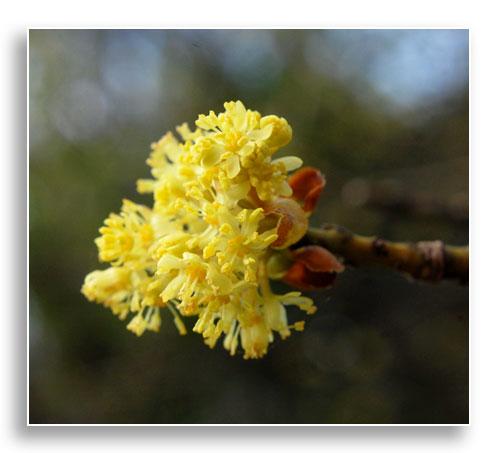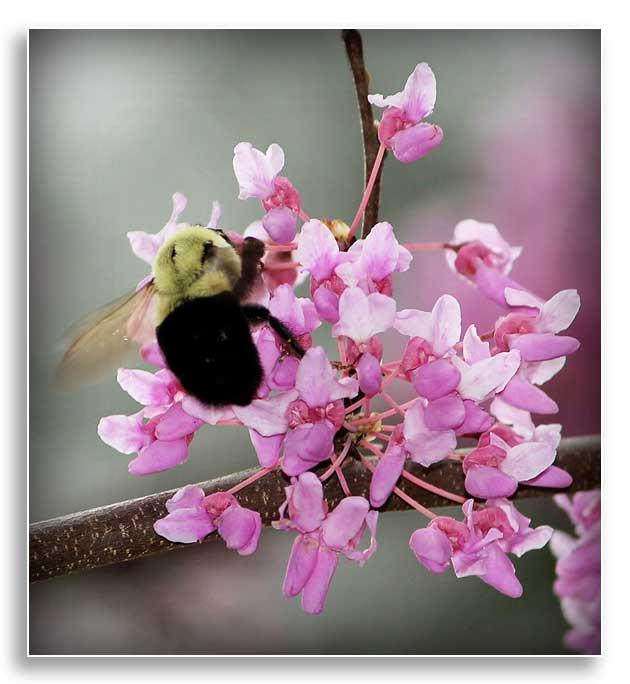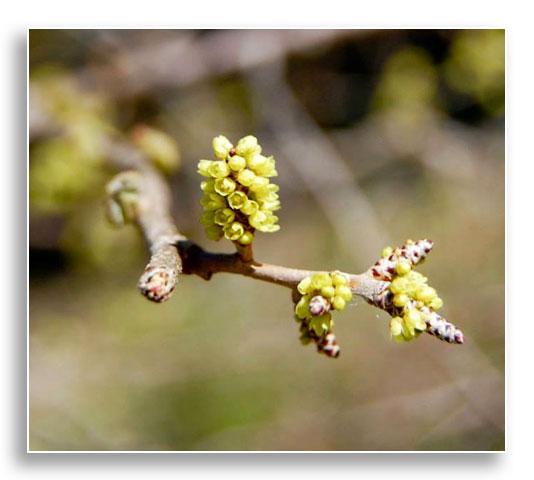Wildlife Connections: Trees for Bees
By Beverly James

As spring approaches and temperatures rise above 55º, some native bees and exotic honeybees begin foraging for food, seeking nectar and pollen from available flowers. Nectar, a source of carbohydrates, provides energy that bees need to build their nests and continue foraging. Pollen provides protein and fat and is critical for successfully raising their broods. Bumblebees are often the first bees active in the spring and the last bees active in the fall, taking advantage of flowers as early as February and as late as November. Timing their emergence with the availability of food, there are many other bees that can be observed in early spring, including Andrena spp. (mining bees), Hoplitis spp. (mason bees), Osmia spp. (mason bees), Lasioglossum spp. (sweat bees), Anthophora spp. (digger bees), Nomada spp. (cuckoo bees), Ceratina spp. (small carpenter bees) and Apis mellifera (honeybees).

Nectar and pollen sources in February, March, and early April are not as abundant as other times of the growing season, but there are many native trees that bloom during this time. Some have inconspicuous flowers high in the canopy, making it difficult for us to see them and their pollinators. With their larger size and abundance of flowers, trees and shrubs can be a convenient and ideal food source for early-emerging bees. Here are a few early-blooming trees and shrubs that provide pollen and/or nectar:
- Pussy willows (Salix discolor) are an excellent early pollen source, blooming March - May, but sometimes as early as February. Males are preferred for the pollen. While pussy willows are considered historically native to Kentucky, they have been used ornamentally for years. The native black willow (Salix nigra) can be found statewide and also provides early forage for bees.
- Red maples (Acer rubrum) bloom March - April and provide both nectar and pollen. At full-bloom, the flowers give the canopy a reddish hue, making them more noticeable than surrounding trees.
- American elm (Ulmus americana) and slippery elm (Ulmus rubra) bloom March - April and provide a source of pollen when other sources are scarce.
- Eastern redbuds (Cercis canadensis) are a widely-used small tree with showy, pink flowers in April that provide nectar and pollen. It’s also favored by the blue orchard bee (Osmia lignaria).
- Serviceberry (Amelanchier arborea), also blooming in April, has white, fragrant, shallow flowers that are appealing to short-tongued bees.
- Sassafras (Sassafras albidum) produces attractive clusters of yellow flowers in April that provide nectar and pollen. Halictid and Andrenid bees are primary pollinators.
- Aromatic sumac (Rhus aromatica) blooms March - April, providing nectar and pollen. The closely related smooth sumac (Rhus glabra) blooms May - June. Twigs can be cut on both species, exposing a soft pith for tunnel-nesting bees.
- Cockspur hawthorns (Cratagus crus-galli) bloom in May, producing nectar and pollen that attract a variety of bee species.

In addition to providing a diversity of plants that bloom throughout the growing season, there are a few other things residents can do to help bees in urban areas. Leaving non-hazardous dead branches in trees, patches of bare soil, and leaf piles can provide nesting habitat for tunnel-nesting and ground-nesting bees. Pesticides can be very harmful to bees and other pollinators and there are many alternative pest control methods available. In situations where pesticides are necessary, it is recommended to apply them when pollinators are not active or where flowers not present. By providing the right plants and practicing bee-friendly landscaping in our yards, parks, and roadsides, we can all contribute to the creation of pollinator corridors in our urban areas and help out our most economically important insects.
Photography
-
Flowers of sassafras (Sassafras albidum) (Beverly James)
-
A bumblebee collects nectar from a Redbud tree at Buckhorn Lake, Buckhorn, Kentucky. (U.S. Army Corps of Engineers Louisville District photo by Priscilla Southwood)
-
Flowers of aromatic sumac (Rhus aromatic) (Beverly James)
About the Author
Beverly James is the Preserve Manager of Floracliff Nature Sanctuary, a 287-acre forest and ecological area in the palisades region of the Kentucky River in southern Fayette County. Email @ bjames@floracliff.org
